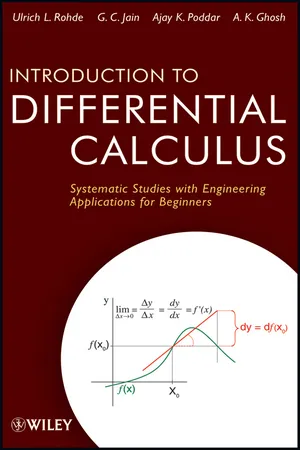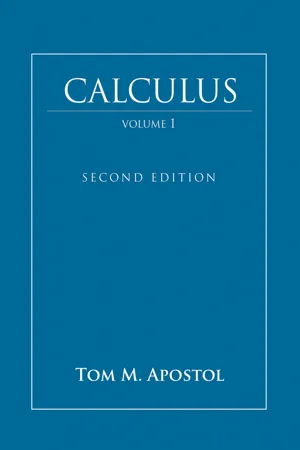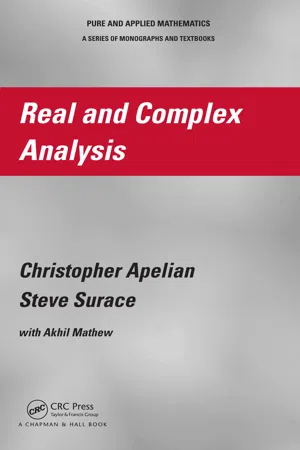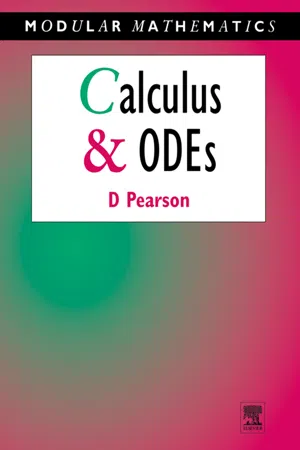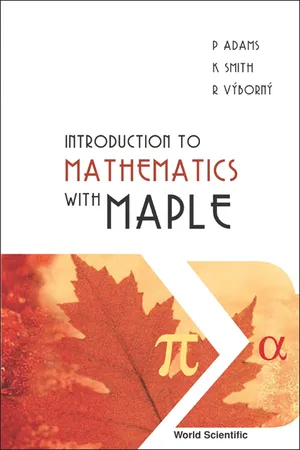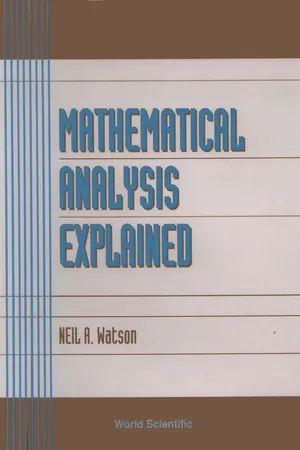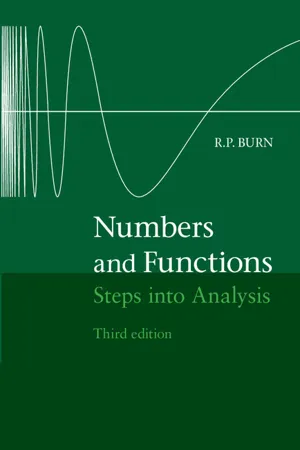Mathematics
Continuity
Continuity in mathematics refers to the property of a function where small changes in the input result in small changes in the output. A function is considered continuous if it can be drawn without lifting the pen from the paper. This concept is fundamental in calculus and analysis, and it helps to understand the behavior of functions and their graphs.
Written by Perlego with AI-assistance
Related key terms
1 of 5
12 Key excerpts on "Continuity"
- eBook - PDF
- Amol Sasane(Author)
- 2015(Publication Date)
- Wiley(Publisher)
3 Continuity Let I be an interval in R . So I is a set of the form ( a , b ) or [ a , b ] or ( −∞ , b ) , etc. Among all possible functions f : I → R , there is a ‘nice’ class of functions, namely ones that are continuous on I . What’s so nice about continuous functions? Continuous functions have properties that make them easy to work with in Calculus. For example, we will see that continuous functions possess two important properties, given by the Intermediate Value Theorem, and the Extreme Value Theorem. We will learn the statements and proofs of these in the course of this chapter. Functions that aren’t continuous may fail to possess these properties. Many bizarre functions make appearances in Calculus, and in order to avoid falling into pitfalls with simplistic thinking, we need definitions and assumptions of theorems to be stated carefully and clearly. 3.1 Definition of Continuity In everyday speech, a ‘continuous’ process is one that proceeds without gaps of interruptions or sudden changes. What does it mean for a function f : R → R to be continuous? Roughly, f is said to be continuous on I if f has ‘no breaks’ at any point of I . If a break does occur in f , then this break will occur at some point of I . So we realise that in order to define Continuity, we need to define what is meant by the notion of ‘ f being continuous at a point c ∈ I ’. Thus (based on this visual view of Continuity), we first try to give the formal definition of the Continuity of a function at a point below. Next, if a function is continuous at each point, then it will be called continuous. If a function has a break at a point c , then even if points x are close to c , the points f ( x ) do not get close to f ( c ) . See Figure 3.1. So ‘no break in f at c ’ should mean that f ( x ) stays close to f ( c ) whenever x is close to c . - eBook - ePub
Introduction to Differential Calculus
Systematic Studies with Engineering Applications for Beginners
- Ulrich L. Rohde, G. C. Jain, Ajay K. Poddar, A. K. Ghosh(Authors)
- 2012(Publication Date)
- Wiley(Publisher)
Chapter 8 The Concept of Continuity of a Function, and Points of DisContinuity 8.1 IntroductionThe study of calculus begins with the concept of limit introduced and discussed in Chapters 7a and 7b. Of all the many consequences of this concept, one of the most important is the concept of a continuous function . One cannot think of the subject of calculus without continuous functions , which we study now.The word continuous means much the same in mathematics as in everyday language. We can introduce the concept of Continuity proceeding from a graphic representation of a function . A function is continuous if its graph is unbroken, i.e., free from sudden jumps or gaps .Suppose a function is defined on an interval I . We say that the function is continuous on the interval I , if its graph consists of one continuous curve , so that it can be drawn without lifting the pencil . There is no break in any of the graphs of continuous functions (Figure 8.1a –c ).Figure 8.1If the graph of a function is broken at any point “a ” of an interval, we say that the function is not continuous (or that it is discontinuous ) at “a ”. We give the following definition:Definition: A function is discontinuous at x = a, if and only if it is not continuous at x = a .This point “a ” is called the point of disContinuity of the function. The domain of a function plays an important role in the definition of Continuity (and disContinuity) of a function. A function may be continuous on one set but discontinuous on another set. It is useful to recall the definitions of the domain of definition and the natural domain - eBook - PDF
- Tom M. Apostol(Author)
- 2019(Publication Date)
- Wiley(Publisher)
Therefore, we have a disContinuity at 2. Note that f (x) does approach f (2) if we let x approach 2 from the right, but this by itself is not enough to establish Continuity at 2. In a case like this, the function is called continuous from the right at 2 and discontinuous from the left at 2. Continuity at a point requires both Continuity from the left and from the right. 126 The definition of the limit of a function 127 In the early development of calculus, almost all functions that were dealt with were continuous and there was no real need at that time for a penetrating look into the exact meaning of conti- nuity. It was not until late in the 18th century that discontinuous functions began appearing in connection with various kinds of physical problems. In particular, the work of J. B. J. Fourier (1758–1830) on the theory of heat forced mathematicians of the early 19th century to exam- ine more carefully the exact meaning of such concepts as function and Continuity. Although the meaning of the word “continuous” seems intuitively clear to most people, it is not obvious how a good definition of this idea should be formulated. One popular dictionary explains Continuity as follows: Continuity: Quality or state of being continuous. Continuous: Having Continuity of parts. Trying to learn the meaning of Continuity from these two statements alone is like trying to learn Chinese with only a Chinese dictionary. A satisfactory mathematical definition of Continuity, expressed entirely in terms of properties of the real-number system, was first formulated in 1821 by the French mathematician, Augustin-Louis Cauchy (1789–1857). His definition, which is still used today, is most easily explained in terms of the limit concept to which we turn now. 3.2 The definition of the limit of a function Let f be a function defined in some open interval containing a point p, although we do not insist that f be defined at the point p itself. - eBook - PDF
- Christopher Apelian, Steve Surace(Authors)
- 2009(Publication Date)
- Chapman and Hall/CRC(Publisher)
5 F UNCTIONS : C ONTINUITY AND C ONVERGENCE The continuous function is the only workable and usable function. It alone is subject to law and the laws of calculation. It is a loyal subject of the mathematical kingdom. Other so-called or miscalled functions are freaks, anarchists, disturbers of the peace, malformed curiosities which one and all are of no use to anyone, least of all to the loyal and burden-bearing subjects who by keeping the laws maintain the kingdom and make its advance possible. E.D. Roe, Jr. In this chapter, we formally define what it means for a function to be continu-ous at a point or on a set. As we will see, continuous functions have many nice properties. We will also consider a special type of Continuity called uniform Continuity. Functions that are uniformly continuous are even nicer in certain ways than functions that are only continuous. We will also apply the limit concept to a sequence of functions, and in this way effectively generalize the notion of sequence, and that of convergence, to “points” that are functions in a function space. Within this context, we take special note of a type of conver-gence called uniform convergence , and determine the particular consequences to which this type of convergence can lead. Finally, we will consider series of functions. While the idea of a series of functions is analogous to that of a series of numbers or a series of vectors, there are some subtleties to explore. Later, series of functions will play a more prominent role in our development of analysis. 1 C ONTINUITY 1.1 Definitions We begin by defining what it means for a function to be continuous at a point. 177 178 FUNCTIONS: Continuity AND CONVERGENCE Definition 1.1 Consider the function f : D → Y . 1. We say that f is continuous at the point x 0 ∈ D if for any > 0, there exists a δ > 0 such that x ∈ D and | x -x 0 | < δ ⇒ | f ( x ) -f ( x 0 ) | < . 2. If f is continuous at every point x 0 ∈ S ⊂ D , we say that f is continuous on S . - eBook - PDF
- David Pearson(Author)
- 1995(Publication Date)
- Butterworth-Heinemann(Publisher)
14 Calculus and ODEs y ----------+----..... ---------x Fig 2.10 The graph of a function f(x). 2.3 What is a continuous function? This book is about calculus. It is not a book on analysis. I assume then, that you would not expect from this book a detailed treatment of notions such as Continuity, limit and so on, with formal definitions and rigorous proofs. That approach to the subject is very much the concern of analysis. I hope that many of my readers will wish to continue their studies into analysis, perhaps after completing this book. Certainly their needs are well catered for by a further volume in this series, and it is one of my aims to have whetted appetites for future work. At my own university, we run a one semester module in calculus in parallel with a module on mathematical reasoning, to be followed by a module on analysis. This does not mean, however, that calculus is simply analysis without the reasoning, without the rigour, and without the need for clear thinking, as it has sometimes been caricatured. I feel that I would be failing in my duty to the reader if I did not attempt to give some idea of what the notions of Continuity and limit mean and why they can be important even to the student who does not intend to pursue the stricter and narrower demands of rigour and abstraction. I shall steer clear of the usual E, 8 definition of Continuity, and instead present an approach which will, I hope, get over the main ideas while being mathematically correct and leading to useful applications. What is a continuous function? Let J be a function and Xo be a point of the domain of! To start with, we should be clear what it means for the functionJto be continuous at Xo. What this means, very roughly, is that if x is close to Xo thenJ(x) is close toJ(xo), and that as x approaches Xo thenj(x) will approachj'(x-). This is, however, too imprecise to qualify as a definition of Continuity. - eBook - PDF
Calculus
Single Variable
- Howard Anton, Irl C. Bivens, Stephen Davis(Authors)
- 2022(Publication Date)
- Wiley(Publisher)
1.4 | Quick Check Answers 1. > 0; δ > 0; 0 < |x − a| < δ 2. limx →1 f (x) = 5 3. δ = /5 4. > 0; N; x > N 5. N = 10,000 1.5 Continuity A thrown baseball cannot vanish at some point and reappear someplace else to continue its motion. Thus, we perceive the path of the ball as an unbroken curve. In this section, we translate “unbroken curve” into a precise mathematical formulation called Continuity, and develop some fundamental properties of continuous curves. Definition of Continuity Intuitively, the graph of a function can be described as a “continuous curve” if it has no breaks or holes. To make this idea more precise we need to understand what properties of a function can cause breaks or holes. Referring to Figure 1.5.1, we see that the graph of a function has a break or hole if any of the following conditions occur: A baseball moves along a “continu- ous” trajectory after leaving the pitcher’s hand. Joseph Helfenberger/iStockphoto • The function f is undefined at c (Figure 1.5.1a). • The limit of f (x) does not exist as x approaches c (Figures 1.5.1b, 1.5.1c). • The value of the function and the value of the limit at c are different (Figure 1.5.1d ). This suggests the following definition. The third condition in Def- inition 1.5.1 actually implies the first two, since it is tacitly understood in the statement lim x →c f(x) = f(c) that the limit exists and the function is defined at c. Thus, when we want to establish Continuity at c our usual pro- cedure will be to verify the third condition only. Definition 1.5.1 A function f is said to be continuous at x = c provided the following conditions are satisfied: 1. f (c) is defined. 2. lim x →c f (x) exists. 3. lim x →c f (x) = f (c). 40 CHAPTER 1 Limits and Continuity x y y = f (x) (b) c x y y = f (x) (c) c x y y = f (x) (d ) c x y y = f (x) (a) c FIGURE 1.5.1 If one or more of the conditions of this definition fails to hold, then we will say that f has a disContinuity at x = c. - No longer available |Learn more
- (Author)
- 2014(Publication Date)
- Library Press(Publisher)
This function is continuous. In fact, there is a dictum of classical physics which states that in nature everything is continuous . By contrast, if M ( t ) denotes the amount of money in a bank account at time t , then the function jumps whenever money is deposited or withdrawn, so the function M ( t ) is discontinuous. (However, if one assumes a discrete set as the domain of function M , for instance the set of points of time at 4:00 PM on business days, then M becomes continuous function, as every function whose domain is a discrete subset of reals is.) Real-valued continuous functions Historical infinitesimal definition Cauchy defined Continuity of a function in the following intuitive terms: an infinitesimal change in the independent variable corresponds to an infinitesimal change of the dependent variable. Definition in terms of limits Suppose we have a function that maps real numbers to real numbers and whose domain is some interval, like the functions h and M above. Such a function can be represented by a graph in the Cartesian plane; the function is continuous if, roughly speaking, the graph is a single unbroken curve with no holes or jumps. In general, we say that the function f is continuous at some point c of its domain if, and only if, the following holds: • The limit of f ( x ) as x approaches c through domain of f does exist and is equal to f ( c ); in mathematical notation, . If the point c in the domain of f is not a limit point of the domain, then this condition is vacuously true, since x cannot approach c through values not equal c . Thus, for example, every function whose domain is the set of all integers is continuous. We call a function continuous if and only if it is continuous at every point of its domain. More generally, we say that a function is continuous on some subset of its domain if it is continuous at every point of that subset. The notation C (Ω) or C 0 (Ω) is sometimes used to denote the set of all continuous functions with domain Ω. - eBook - PDF
- Robert G. Bartle, Donald R. Sherbert(Authors)
- 2011(Publication Date)
- Wiley(Publisher)
CHAPTER 5 CONTINUOUS FUNCTIONS We now begin the study of the most important class of functions that arises in real analysis: the class of continuous functions. The term ‘‘continuous’’ has been used since the time of Newton to refer to the motion of bodies or to describe an unbroken curve, but it was not made precise until the nineteenth century. Work of Bernhard Bolzano in 1817 and Augustin-Louis Cauchy in 1821 identified Continuity as a very significant property of functions and proposed definitions, but since the concept is tied to that of limit, it was the careful work of Karl Weierstrass in the 1870s that brought proper understanding to the idea of Continuity. We will first define the notions of Continuity at a point and Continuity on a set, and then show that various combinations of continuous functions give rise to continuous functions. Then in Section 5.3 we establish the fundamental properties that make continuous functions so important. For instance, we will prove that a continuous function on a closed bounded interval must attain a maximum and a minimum value. We also prove that a continuous function must take on every value intermediate to any two values it attains. These properties and others are not possessed by general functions, as various examples illustrate, and thus they distinguish continuous functions as a very special class of functions. In Section 5.4 we introduce the very important notion of uniform Continuity. The distinction between Continuity and uniform Continuity is somewhat subtle and was not fully appreciated until the work of Weierstrass and the mathematicians of his era, but it proved to be very significant in applications. We present one application to the idea of approximating continuous functions by more elementary functions (such as polynomials). Karl Weierstrass Karl Weierstrass (¼Weierstrab) (1815–1897) was born in Westphalia, Germany. - eBook - PDF
- Paul Zeitz(Author)
- 2016(Publication Date)
- Wiley(Publisher)
Of the many equivalent formal definitions, the following is one of the easiest to use. Let ∶ → ℝ and let ∈ . We say that is continuous at if lim →∞ ( ) = () for all sequences ( ) in with limit . We call continuous on the set if is continuous at all points in . Continuity is a condition that you probably take for granted. This is because virtually every function that you have encountered (certainly most that can be written with a simple formula) are continuous. 5 For example, all elementary functions (finite combinations of polynomials, rational functions, trig and inverse trig functions, exponential and logarithmic functions, and radicals) are continuous at all points in their domains. Consequently, we will concentrate on the many good properties that continuous functions possess. Here are two extremely useful ones. Intermediate-Value Theorem (IVT) If is continuous on the closed interval [, ], then assumes all values between () and (). In other words, if lies between () and (), then there exists ∈ [, ] such that () = . Extreme-Value Theorem If is continuous on the closed interval [, ], then attains minimum and maximum values on this interval. In other words, there exists , ∈ [, ] such that () ≤ () and () ≥ () for all ∈ [, ]. 5 Notable exceptions are the floor and ceiling functions ⌊⌋ and ⌈⌉. 9.2. Convergence and Continuity 325 The extreme-value theorem seems almost without content, but examine the hypothesis carefully. If the domain is not a closed interval, then the conclusion can fail. For example, () ∶= 1∕ is con- tinuous on (0, 5), but achieves neither maximum nor minimum values on this interval. On the other hand, the IVT, while “obvious” (see Problem 9.2.22 for hints about its proof), has many immediate applications. Here is one simple example. The crux move, defining a new function, is a typical tactic in problems of this kind. - eBook - PDF
- P Adams, K Smith;R V??born??;;(Authors)
- 2004(Publication Date)
- WSPC(Publisher)
Formally, we make the following definition: Limits and Continuity of Functions 333 12.6 (Continuity) A function f is said to be continuous at 2, continuous from the right at 2 or continuous from the left at 2 if (respectively. Example 12.11 By Example 12.8 the function x H x3 is continuous a t 3, the floor function is obviously continuous from the right a t n E N since liml(z)J = n = LnJ and similarly the function ceil is continuous from the xln left a t n E N. More generally, every polynomial is continuous a t every 2, the greatest integer function is continuous from the right a t every point and the ceil function is continuous from the left a t every point. Usually, we say discontinuous instead of not continuous. For example the floor function is discontinuous from the left at any integer and the function ceil is discontinuous from the right at any n E Z. In mathematics it is sometimes convenient to consider functions which have values 00 or -00. We do not do this in this book and, in particular, in Definition 12.6 the limit is understood as a finite limit. However, even in situations where infinite values are allowed, the function is considered to be discontinuous where lim f(x) = f(2) = foo. In the past, mathematicians believed that for a function to be contin- uous everywhere was normal and to be discontinuous was an exception. To a certain extent this is somewhat tenable even today in the sense that most functions encountered in applications are continuous apart from a few points. However, today some functions discontinuous at many or even all points of the domain of definition play an important part in mathematics and in applications. Some examples of functions with discontinuities are discussed in Exercises 12.4.4-12.4.6. Obviously there are many functions continuous everywhere, for instance polynomials. - eBook - PDF
- Neil A Watson(Author)
- 1993(Publication Date)
- WSPC(Publisher)
Chapter 3 CONTINUOUS FUNCTIONS Functions, limits, and Continuity Given two sets X and Y, and rules which together associate a single element of Y to each element of X, we have what is called a function from X into Y. If we denote the function by / , then f(x) is the element of Y associated with the element x of X. We write / : X —• Y if / is a function from X into Y. Example. A sequence {s n } is a function from N to R , where we write {s n } instead of / , and s n instead of f(n). Example. Suppose that, for each x > 0, we try to define y G R by putting y 2 = x. Then y is not a function of x, since if x = 1 then both 1 and —1 are possible values of y, and a function would have a single value of y. B y analogy with the corresponding definition for a sequence, we can define what is meant by f(x) tending to a limit as x —> oo. DEFINITION. Let / : ]a, oo[-> R for some a G R . Then f(x) tends to a limit I as x —> oo if, to each e > 0 there corresponds xo such that f(x) — l < e for all x > xo . We then write f(x) —> I as x —> oo, or lim f(x) = /. £—•00 A similar definition can be formulated for the case where x — • — 00. Example. Let / :]0, oo[—• R be defined by „ . x + 1 x Then f(x) — » 1 as x — > 00; for if € > 0, we have | / ( x ) -l | = i < e 32 Functions, limits, and Continuity 33 whenever x > 1 /e. (Here 1 /e corresponds to the #0 in the definition.) With functions, another situation may arise which does not occur with sequences. It may happen that f(x) tends to a limit I as x approaches a fixed real number c, either from the left (x —• c-) or from the right (x -* c+). To formulate the definitions, all we have to do is replace all x sufficiently close to 0 0 , i.e. all x > x$ by all x sufficiently close to c (either to the left or to the right). - eBook - PDF
Numbers and Functions
Steps into Analysis
- R. P. Burn(Author)
- 2015(Publication Date)
- Cambridge University Press(Publisher)
The terms injection, surjection and bijection were devised by the twentieth-century corporate French mathematician Bourbaki. It has always been accepted that an equation like x 2 + y 2 = 1 determines a functional relationship between y and x . But a given value of x between ± 1 gives two possible values of y , since y = ± √ ( 1 − x 2 ) . Such many-valued functions appear in the literature right through the nineteenth century, and functions were taken to be single-valued only when they were said to be so. However, for the purposes of defining Continuity, limits, and inverse functions, single-valued functions are essential and so during the twentieth century functions have come to mean single-valued functions, though this convention is still not universal. In order to formulate the Intermediate Value Theorem both Bolzano (1817) and Cauchy (1821) needed a definition of Continuity, and said that f was continuous when f ( x + h ) − f ( x ) became small with h . Their definitions are recognisable as our neighbourhood definition of Continuity though they only considered functions which were continuous at least on an interval, not just at an isolated point. For his proof of the Intermediate Value Theorem, Bolzano needed the result that a function which is continuous and takes a non-zero value at a point must be non-zero in a neighbourhood of that point. The first ε − δ description of a limit appears in Cauchy’s description of derivative (1823) without symbolic use of absolute values or inequalities. The 166 6 Functions and Continuity ε − δ definition of limit was formulated by Weierstrass using the modern notation for absolute value, which he introduced, in his first lectures in Berlin (1859). The equivalence of the neighbourhood definition and the sequential definition was established by Cantor in 1871 and the sequential definition of Continuity was proposed by Cantor and Heine in 1872. In 1872, Heine published the definition of Continuity at a point .
Index pages curate the most relevant extracts from our library of academic textbooks. They’ve been created using an in-house natural language model (NLM), each adding context and meaning to key research topics.

